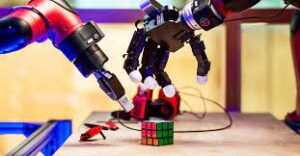“We’re imagining an approach for global ocean exploration where you take swarms of smaller robots of various types and populate the ocean with them for tracking, for climate change, for understanding the physics of the ocean,” says John O. Dabiri, a professor of aeronautics and mechanical engineering at the California Institute of Technology.
In comes CARL-Bot (Caltech Autonomous Reinforcement Learning Robot), a palm-sized aquatic robot that looks like a cross between a pill capsule and a dumbo octopus. It has motors for swimming around, is weighted to stay upright, and has sensors that can detect pressure, depth, acceleration, and orientation. Everything that CARL does is powered by a microcontroller inside, which has a 1-megabyte processor that’s smaller than a postage stamp.
CARL is the latest ocean-traversing innovation out of Dabiri’s lab, created and 3D-printed at home by Caltech graduate student Peter Gunnarson. The first tests Gunnarson ran with it were in his bathtub, since Caltech’s labs were closed at the start of 2021 because of COVID.
Right now, CARL can still be remotely controlled. But to really get to the deepest parts of the ocean, there can’t be any hand-holding involved. That means no researchers giving CARL directions—it needs to learn to navigate the mighty ocean on its own. Gunnarson and Dabiri sought out computer scientist Petros Koumoutsakos, who helped develop AI algorithms for CARL that could teach it to orient itself based on changes in its immediate environment and past experiences. Their research was published this week in Nature Communications.
CARL can decide to adjust its route on-the-fly to maneuver around the rough currents and get to its destination. Or it can stay put in a designated location using “minimal energy” from a lithium-ion battery.
Source : https://www.popsci.com/technology/caltech-carl-bot-ai-ocean-robot/







